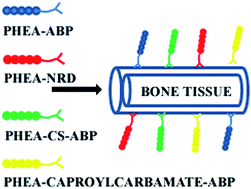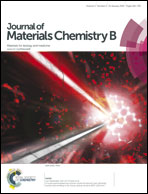Bisphosphonate–polyaspartamide conjugates as bone targeted drug delivery systems†
Abstract
Poly-hydroxy-aspartamide was used as a backbone to synthesize bisphosphonate derivatives thus achieving macromolecular carriers to be potentially used as targeting agents for bone drug delivery. Molecules bearing bisphosphonate groups, such as aminobisphosphonate (ABP) and neridronate (NRD), have been conjugated to polyaspartamide (α,β-poly(N-2-hydroxyethyl)-DL-aspartamide, PHEA), with or without a spacer (succinic acid or 6-aminocaproic acid) thus obtaining PHEA-succinate-ABP and PHEA-caproylcarbamate-ABP and PHEA-ABP and PHEA-NRD, respectively. Bisphosphonate–polymer conjugates were physico-chemically characterized using size exclusion chromatography and 1H-NMR; and their in vitro and ex vivo affinity for bone tissue has been further tested using the hydroxylapatite and rabbit bone binding assays, respectively. In vivo studies were carried out using rats to evaluate the biodistribution features of bisphosphonate–polymer conjugates in comparison with the starting PHEA. In vivo findings evidenced a suitable selectivity of bisphosphonate–polymer conjugates toward the bone tissues also as a function of time.


 Please wait while we load your content...
Please wait while we load your content...